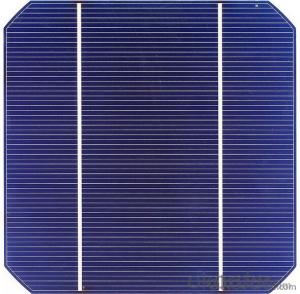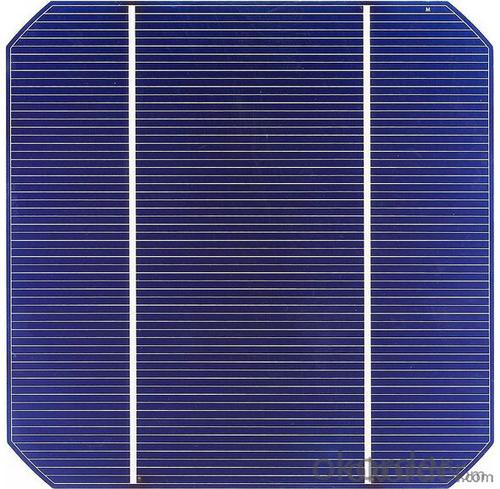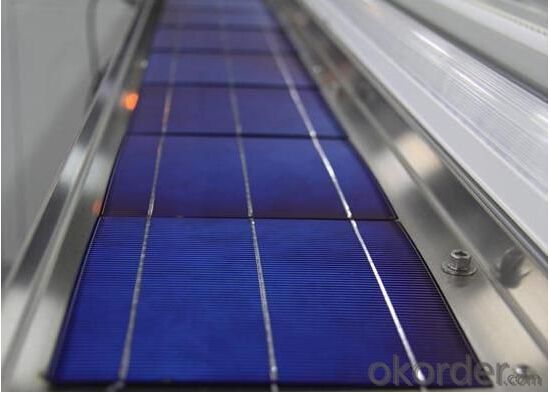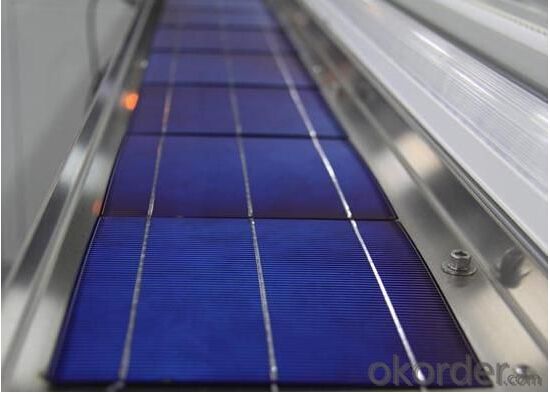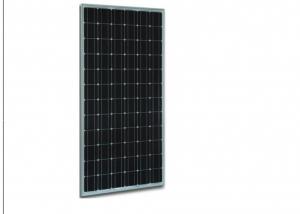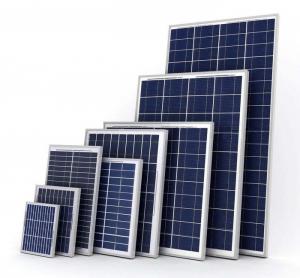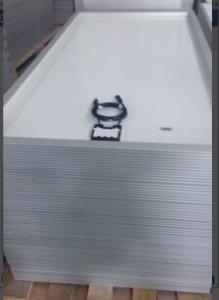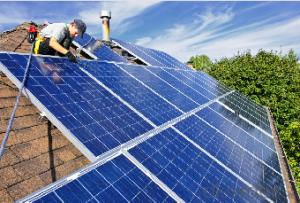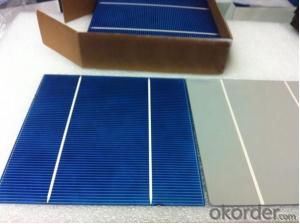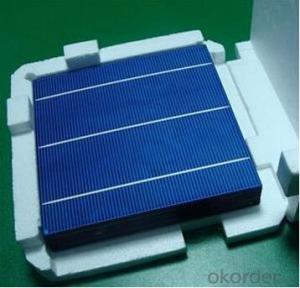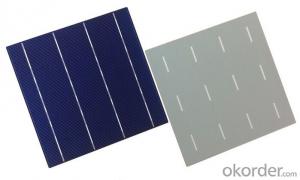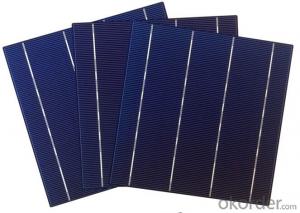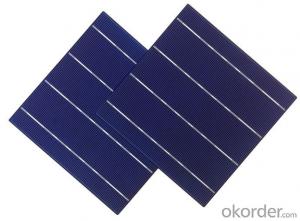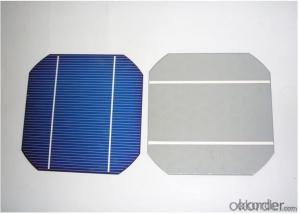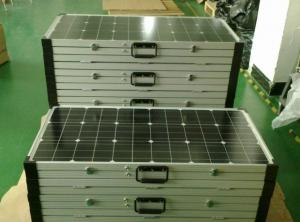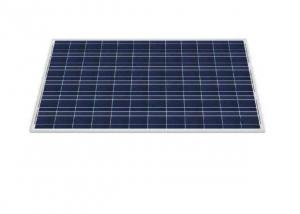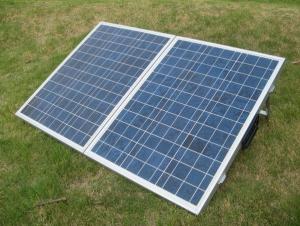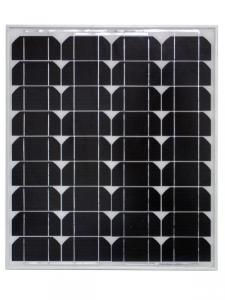Solar Panels Melbourne Victoria - A Grade and B Grade 3BB and 4BB High Efficiency Solar Cells 18.1%
- Loading Port:
- Shanghai
- Payment Terms:
- TT OR LC
- Min Order Qty:
- 10000 watt
- Supply Capability:
- 100000000 watt/month
OKorder Service Pledge
OKorder Financial Service
You Might Also Like
Specification
1.Product Description:
Specifications of Poly Solar Cells
Dimension | 156mm X 156 mm ±0.5mm |
Wafer Thickness | 200um ±30um |
Front(-) | Four 1.1mm wide bus bars(silver) with distance 39mm, Acid texturized surface with blue silicon nitride AR coating. |
Back(+) | 2.4mm wide silver/aluminum soldering pads, aluminum back surface field. |
Temperature Coefficient of Poly Cells
Voc.Temp .coef.%/K | -0.351%/K |
Isc.Temp .coef.%/K | +0.035%/K |
Pm.Temp. coef.%/K | -0.47%/K |
Electrical Characteristic of Poly Cells
Efficiency code | 1720 | 1740 | 1760 | 1780 | 1820 | 1840 | |
Efficiency (min) | (%) | 17.2 | 17.4 | 17.6 | 17.8 | 18.2 | 18.4 |
Pmax | (W) | 4.186 | 4.234 | 4.283 | 4.332 | 4.429 | 4.478 |
Voc | (V) | 0.631 | 0.632 | 0.634 | 0.636 | 0.640 | 0.642 |
Isc | (A) | 8.446 | 8.485 | 8.523 | 8.573 | 8.660 | 8.700 |
Vmp | (V) | 0.525 | 0.527 | 0.529 | 0.531 | 0.535 | 0.537 |
Imp | (A) | 7.973 | 8.035 | 8.097 | 8.160 | 8.280 | 8.340 |
2.Advantages of Poly Solar Cells
1). Tire-1 Solar Cells’ Manufacturer Quality Guarantee. With a complete and sophisticated quality government system, our Quality Management have arrived world’s leading place. Customer can receive Tire-1 Cells Maker’s Quality Standard Products.
2). Trusted Warranty. We can supply trusted after-sales service to our customer. If our cells are found not in conformity to the specification of manufacturer, or should the inspected quantity found in shortage, or should the packing found damaged, the buyer has the right to claim to the seller. The claim, if any, should be presented to seller within 30 days after cargo's arrival date to the port, together with related inspection report and photos issued and provided by a reputable independent surveyor such as SGS.
3). World’s Leading Manufacturer Equipment. We imported the newest and leading production equipment from abroad. Advanced equipment can guarantee the stable quality of cells. Auto production line can also save labor cost which will further cut our production cost.
4). Bulk supply: With the production capacity of 500MW, we can produce large quantity every month. This can satisfy most customer requirement.
3.Usage and Applications of Poly Cells
Solar cells are often electrically connected and encapsulated as a module.
Photovoltaic modules often have a sheet of glass on the front (sun up) side, allowing light to pass while protecting the semiconductor wafers from abrasion and impact due to wind-driven debris, rain, hail, etc. Solar cells are also usually connected in series in modules, creating an additive voltage.
Connecting cells in parallel will yield a higher current;our solar cells have passed IEC Certification.
With high quality and stable quality. Our Cells can greatly improve the performance of Solar Modules.
4.Pictures of Product
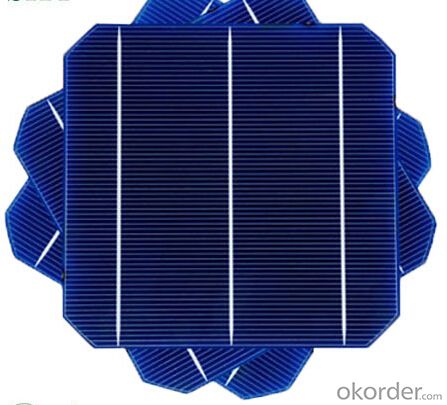
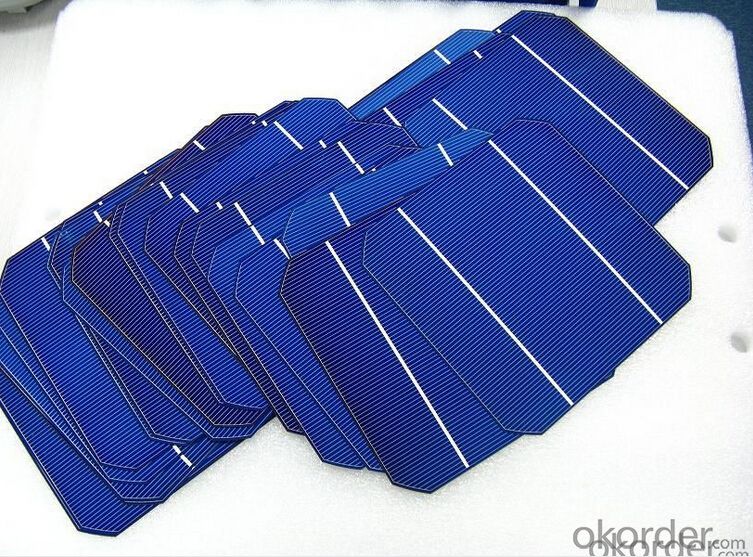
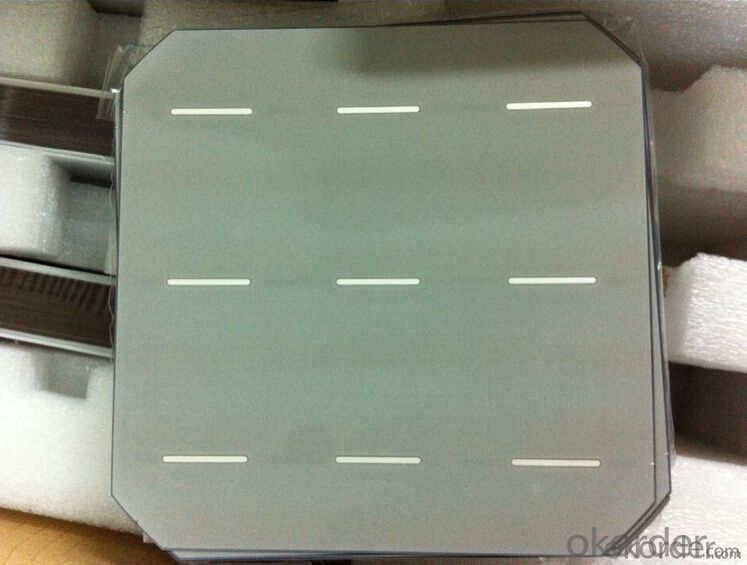
5.Packaging & Delivery of Poly Cells
Carton Box Package and Deliver by air. It should be noticed that it should be avoid water, sunshine and moist.
We have organized several common questions for our clients,may help you sincerely:
6.FAQ
1. What’s price per watt?
A: It’s depends on the quantity, delivery date and payment terms of the order. We can talk further about the detail price issue. Our products is high quality with lower price level.
2. Can you tell me the parameter of your solar cells?
We have different series of cells with different power output, both from c-si to a-si. Please take our specification sheet for your reference.
3. How do you pack your products?
We have rich experience on how to pack the panels to make sure the safety on shipment when it arrives at the destination.
4. Can you do OEM for us?
Yes, we can.
5. How long can we receive the product after purchase?
In the purchase of product within three working days, We will arrange the factory delivery as soon as possible. The perfect time of receiving is related to the state and position of customers. Commonly 7 to 10 working days can be served.
- Q: What is the main material for making solar panels?
- If you make your own, in addition to buying silicon also need to buy for the packaging of silicon photovoltaic glass and EVA film.
- Q: Can solar panels be used to power a factory?
- Yes, solar panels can be used to power a factory. By installing a large number of solar panels on the factory's roof or in nearby open spaces, the generated solar energy can be harnessed and converted into electricity to meet the power requirements of the factory. This can help reduce the dependency on traditional grid electricity and also contribute towards a more sustainable and environmentally friendly operation of the factory.
- Q: I have 2 solar panels one is 5 watts 2 volts .2 amps or -The other is 50 watts 2 volts 2.6 amps or-Can I ...and what is the best way to hook them togeather to increase my amps being put back to my battery ?? I would be hooking them up to a 7 amp 00 watt charge controllerThe panels are rated 2 volt but the specs say they will produce more whennot connected to charge controllerPlease advise and should I even bother with the smaller panel ?
- The answer is that the two panels should be put in parallel. The voltage out will drop to the voltage of the lower panel, but you should get most of the power, if the panels aren't too badly mismatched. I would try to get a multimeter and try to measure the actual current coming out of the panels in full sun. Sometimes the specifications on these smaller panels are very optimistic. If the whole setup is putting out less than 2 amps, I'd say wire the whole thing straight to the battery - little chance of boiling the electrolyte at those currents.
- Q: I had an idea for new parabolic solar panels shaped like horseshoes. They can install them outside buildings facing the equator. They could angle them from the ground based on how many degrees latitude the location and rotate them according to seasonal changes. The disadvantage of photovoltaic panels is that they are not all capable of receiving direct sunlight. That is the quintessential reason I believe horseshoe solar panels are more effective than flat rectangular ones. One side could function in the morning; the middle could perform at midday; and the other could operate during the evening. That method seems more sensible than hourly positioning. I'm certain horseshoe panels could save and produce more electricity. A football stadium, shopping mall, or outlet center would be a fantastic place. What do you think?
- Sounds like you are thinking which is excellent. Now do a controlled experiment. Using a prototype of your receiver and measure it against existing technology. You could do a computerized mock up.
- Q: Can solar panels be used in areas with high pollution?
- Yes, solar panels can be used in areas with high pollution. While pollution can reduce the efficiency of solar panels to some extent by blocking sunlight, they can still generate electricity. However, regular maintenance and cleaning of the panels may be required to ensure optimal performance. Additionally, the use of advanced technologies and designs can help mitigate the effects of pollution on solar panel efficiency.
- Q: Can solar panels be installed in areas with high pollution levels?
- Yes, solar panels can be installed in areas with high pollution levels. While pollution may slightly affect the efficiency of solar panels by reducing sunlight exposure, they can still generate electricity and contribute to reducing the overall carbon footprint. Additionally, installing solar panels in polluted areas can help promote cleaner energy sources and potentially improve air quality over time.
- Q: Can solar panels be used for charging electric scooters?
- Yes, solar panels can be used for charging electric scooters. By connecting the solar panels to an appropriate charge controller and then to the scooter's battery, solar energy can be harnessed and stored to power the scooter, providing a clean and renewable source of energy. However, the efficiency of solar panels may vary depending on various factors such as the size of the panel, sunlight availability, and the scooter's power requirements.
- Q: Can solar panels be installed on research facilities or laboratories?
- Yes, solar panels can be installed on research facilities or laboratories. In fact, many research facilities and laboratories are increasingly adopting solar energy as a clean and sustainable power source. The installation of solar panels helps reduce carbon emissions, lowers electricity costs, and promotes a greener and more environmentally-friendly approach to conducting scientific research.
- Q: How much electricity can a solar panel generate?
- The amount of electricity a solar panel can generate depends on factors such as its size, efficiency, location, and weather conditions. On average, a standard residential solar panel can generate around 250 to 400 watts per hour under optimal conditions. However, it is important to note that solar panels are typically installed in arrays, so the total electricity generation can be scaled up by adding more panels.
- Q: I am currently building a house, iv designed it to be as self sustainable as possible, I'm in the process of installing solar panels but as I'm ordering online I was hoping someone here could tell me how many I would need to completely run a 5 bedroom home, just standard household appliances such as fridge and freezers, plasma tvs computers and of course lighting, various things like that, also I'll need power storage as well, some type of large rechargeable battery, any help would be great.
- A typical home in America can use either electricity or gas to provide heat -- heat for the house, the hot water, the clothes dryer and the stove/oven. If you were to power a house with solar electricity, you would certainly use gas appliances because solar electricity is so expensive. This means that what you would be powering with solar electricity are things like the refrigerator, the lights, the compute?r, the TV, stereo equipment, motors in things like furnace fans and the washer, etc. Let's say that all of those things average out to 600 watts on average. Over the course of 24 hours, you need 600 watts * 24 hours = 4,400 watt-hours per day. From our calculations and assumptions abo?ve, we know that a solar panel can generate 70 milliwatts per square inch * 5 hours = 350 milliwatt hours per day. Therefore you need about 4,000 square inches of solar panel for the house. That's a solar panel that measures about 285 square feet (about 26 square meters). That would cost around $6,000 right now. Then, because the sun only shines part of the time, you would need to purchase a battery bank, an inverter, etc., and that often doubles the cost of the installation. If you want to have a small room air conditioner in your bedroom, double everything.
Send your message to us
Solar Panels Melbourne Victoria - A Grade and B Grade 3BB and 4BB High Efficiency Solar Cells 18.1%
- Loading Port:
- Shanghai
- Payment Terms:
- TT OR LC
- Min Order Qty:
- 10000 watt
- Supply Capability:
- 100000000 watt/month
OKorder Service Pledge
OKorder Financial Service
Similar products
Hot products
Hot Searches
Related keywords
